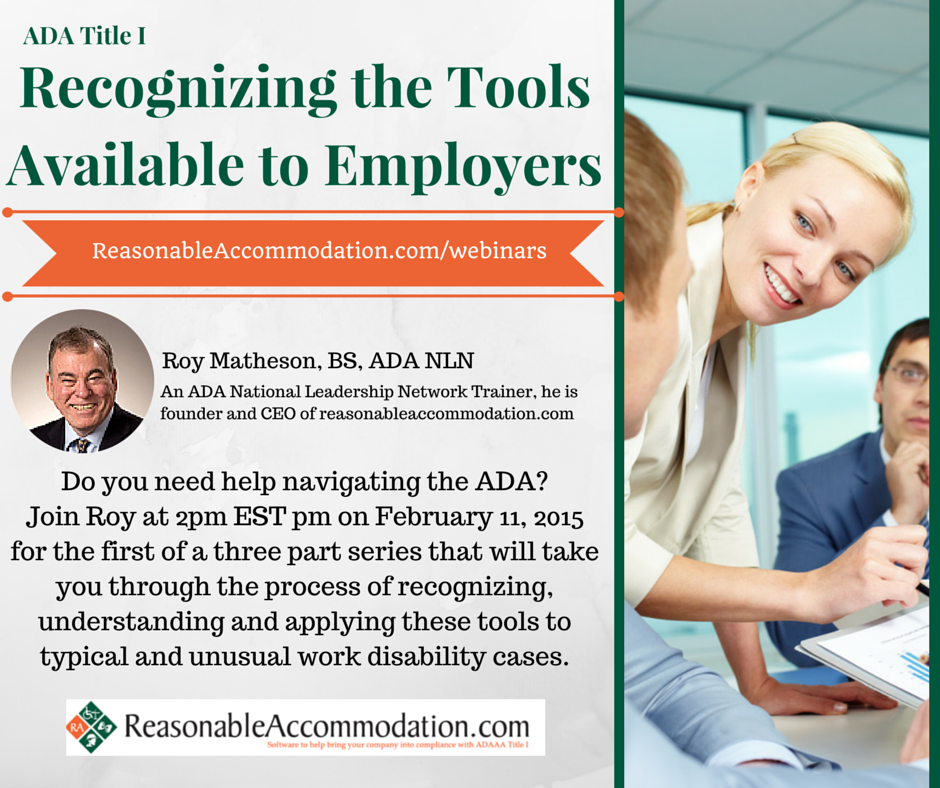This is the final blog in the 3-part series. This three part blog series will acquaint you with the hiring, disability, and absence management tools Congress provided to employers through Title I of the amended Americans with Disabilities Act.
*************************************************************************
Module Three – ADA Title I: Applying the Tools Available to Employers
Human resource, safety, and risk management professionals exercise leadership in their company, school, or government agencies through adoption and effective use of the tools provided by Title I of the ADAAA.
The final module in this three-part series begins with a review of cases that resulted from NOT using the tools provided by the ADA. Each problematic example is followed by an
example of successful use of the tools. The verbiage in italics comes from the law itself.
(8) Qualified individual. – The term “qualified individual” means an individual who, with or without reasonable accommodation, can perform the essential functions of the employment position that such individual holds or desires. For the purposes of this subchapter, consideration shall be given to the employer’s judgment as to what functions of a job are essential, and if an employer has prepared a written description before advertising or interviewing applicants for the job, this description shall be considered evidence of the essential functions of the job.
As I wrote earlier in this series, having an essential function job analysis to define the job is the foundation of your defense in an ADA-based work discrimination case. One of the most famous cases was heard in the United States Court of Appeals for the First Circuit. Kelly A. Gillen v Fallon Ambulance Service, Inc. (No. 01-1642) is the case of a young women who applied to be an EMT. The company slid down a slippery slope of errors including not have a valid description of the job. Instead, the company relied on their inaccurate belief of how the job had to be done. Gillen is important because of the multiple lessons learned in one reading.
(9) Reasonable accommodation. – The term “reasonable accommodation” may include-
(A) making existing facilities used by employees readily accessible to and usable by individuals with disabilities; and
(B) job restructuring, part-time or modified work schedules, reassignment to a vacant position, acquisition or modification of equipment or devices, appropriate adjustment or modifications of examinations, training materials or policies, the provision of qualified readers or interpreters, and other similar accommodations for individuals with disabilities.
As I said in an earlier part of this blog series, reasonable accommodation is one of the major tools provided to both employees and employers for managing hiring, stay-at-work, and return-to-work situations. But the reason it is so powerful goes beyond the obvious. I strongly encourage you to push the reasonable accommodation tool out to physicians and case managers who make medical restriction and return-to-work decisions for your employees. When they understand how to use the tools, your return to work cycle times will decrease. Use your knowledge of what the job requires to validate the relevance of the medical restriction as a reason for absence from work. Ask yourself, “If the demand of the job is less than the restriction, why is the individual absent from work”? And, “If the restriction can be safely accommodated, why is the individual absent from work”? The ADAAA gives the employer the tools to actively manage the safe return-to-work process.
And finally we come to an underused, powerful tool:
(d) Medical examinations and inquiries. –
(3) Employment entrance examination. – A covered entity may require a medical examination after an offer of employment has been made to a job applicant and prior to the commencement of the employment duties of such applicant, and may condition an offer of employment on the results of such examination,
An employment entrance examination is intended to identify the individual who is unable to safely execute the physical demands of the essential functions of a job; in error it is often thought that this examination identifies those who can safely do the job.
(4) Examination and inquiry. –
(A) Prohibited examinations and inquiries. – A covered entity shall not require a medical examination and shall not make inquiries of an employee as to whether such employee is an individual with a disability or as to the nature or severity of the disability, unless such examination or inquiry is shown to be job related and consistent with business necessity.
(B) Acceptable examinations and inquiries. – A covered entity may conduct voluntary medical examinations, including voluntary medical histories, which are part of an employee health program available to employees at that work site. A covered entity may make inquiries into the ability of an employee to perform job-related functions.
Once an individual has been legally hired by the company, the employer may test the individual for the safe ability to conduct the physical demands tied to the essential functions of the job. As with most human resource issues, the practice of testing is not quite as simple as the previous sentence may indicate. But rest assured, if you go about testing in a straight forward and fair way, if you focus on keeping people safe, you have the ability to validate whether or not your workers can safely perform the demands of the job. And, as an added value, in the case of an absent employee, you can rely on this type of test to validate that the individual is participating in the evaluation with high levels of physical effort.
Paul James v The Goodyear Tire and Rubber Company (No. 08-6332), which was heard in the United States Sixth Circuit Court of Appeals, lays a clear path to the proper use of a test to determine the ability of an individual to safely perform the demands of the job. If your company uses outside testing vendors, be sure they have read and adhere to the standards endorsed by the court in this case.
An example of how not to do return-to-work testing is Indergard v Georgia-Pacific Corporation (No. 08-35278), heard before the United States Court of Appeals, Ninth Circuit. This case tells the story of how employment testing was done before the federal court weighed in with ADA-based guidance.
To close, Title I of the ADA gives employers powerful tools to manage the safety of their incumbent works. Whether the individual is at work or is absent from work due to a disability, tools exist to close the gap between an estimation of the worker’s residual ability and the accommodated demands of the job.



